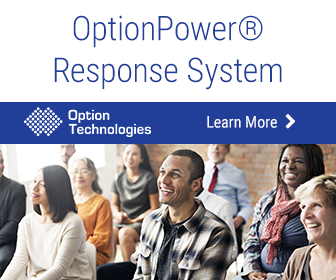Can we get a show of hands? How many people are tired of doing guesswork about audience feedback?
Traditionally, asking the crowd to raise their hands, or perhaps quickly walking around chatting with random people, was the only way to get immediate audience feedback. What a clumsy, inaccurate method - but it’s all we had.
Unfortunately, that old-fashioned route is full of error. Here are some big drawbacks of raise-your-hand audience polls:
- No anonymity
- Embarrassment and annoyance
- Confusion about what’s being asked
- Inaccurate counts
- Only works on yes/no questions
- No opportunity for deeper feedback
Tech-Infused Interactions
Here’s the good news: Audience polling has changed. Technology now allows presenters to read the minds of the audience members through two-way handheld devices and real-time enabled presentations. Audience members use software, the web, or text messaging to communicate with the presenter.
It’s truly a revolution in communicating with crowds of people - which is why it’s so popular at big companies and universities. At this point, well over 50% of Fortune 500 companies use some kind of audience response system (ARS) for meetings and many city governments are investing in them for community outreach. Notably, Americaspeaks.org now uses ARS for its nationwide 21st Century Town Meetings format.
Engaging Minds
With ARS, presenters not only read the audience’s minds, but engage their minds in analyzing and retaining information as it’s presented. This sets the stage for active learning, rather than passive listening.
The University of Wisconsin system, a group of 4 universities, distributed ARS systems to classrooms to gauge their effect on student engagement. They found that 94% of professors agreed or strongly agreed that the ARS boosted engagement, and zero disagreed or strongly disagreed. Student reactions were similarly positive.
Asking, Not Assuming
Another big benefit of ARS systems is that they capture the audience’s true feelings, without interference from the presenters’ assumptions. Anonymity allows people to feel comfortable sharing awkward questions, unpopular views, and cries for help in understanding the material.
This is particularly important in fields where 100% accuracy is critical, like hospital patient care, social/children’s services, and government polling. An atmosphere of anonymity encourages honest feedback - sometimes brutally honest - that helps organizations move toward positive change.
At Option Technologies, we’ve seen impressive ARS results in fields like:
- Government/community town hall meetings
- Municipal and environmental impact planning
- Religious conferences
- Corporate training
- Manufacturing
- Publishing and point-of-sales
- Employee assessments and self-assessments
- Market research and development
- Conferences and events
- Continuing education for medical workers and teachers
- University education and educational events
- Hospital patient surveys and medical technology
- Continuing Medical Education
- Sales seminars and sales retraining
How it Works
Creating an ARS-enabled presentation is like mixing a PowerPoint with a game show. The presentation is created in advance, including visuals, a spoken script, and questions for the audience. Use popular formats like PowerPoint, Google Slides, and Keynote.
When you go live, audience feedback is requested at key times and people are directed how to respond. Their answers may be gathered using the web/cloud, on-site software, or handheld mobile devices - all depending on how you customize the presentation for your needs.
Ask yes/no questions, request multiple choice answers, or spark lively debate with open-ended responses. Engage the audience with questions/statements like:
- Do you plan to stay employed with our company for the next 2 years? Yes/No
- In one word, describe the last sales meeting you attended.
- Do you think our city recycles more, less, or the same as the average U.S. city?
- Rate your understanding of the material presented today: high medium low
Immediately, right before the audience’s eyes, results are displayed in your presentation: charts, graphs, text blocks, whatever matches your format. Poll-style feedback is shared with the group; more detailed feedback can be gathered privately to preserve anonymity.
Addressing Audience Needs
After the meeting, the presenters can run reports that illuminate how the audience responded. Stats can be deeply analyzed to identify areas for improvement, making the effects of the meeting long-lasting.
For example, if 60% of your sales employees responded “I don’t know” to an important question about their market, that shows you still have a long way to go. A follow-up meeting may be needed or perhaps the company should dispatch on-site sales trainers for further education.
An ARS can truly read the minds of your audience, providing actionable feedback that can be used in long-term strategic planning. Explore your company’s ARS options now with the help of Option Technologies.


